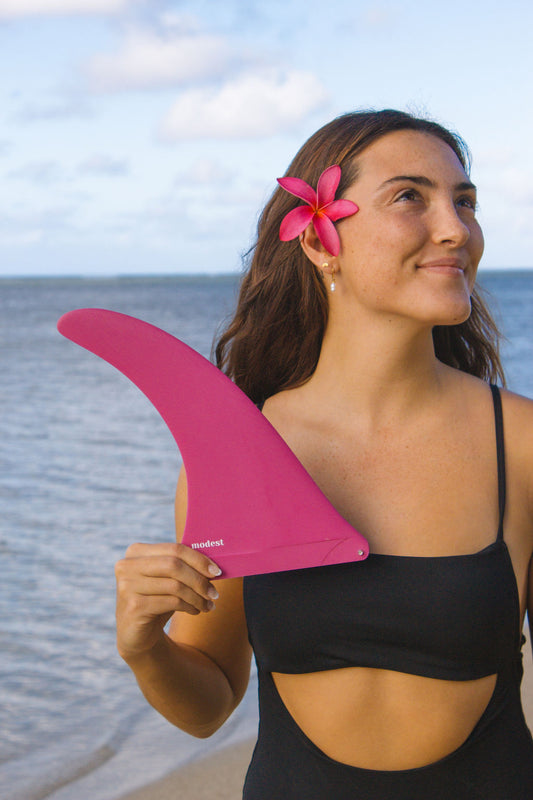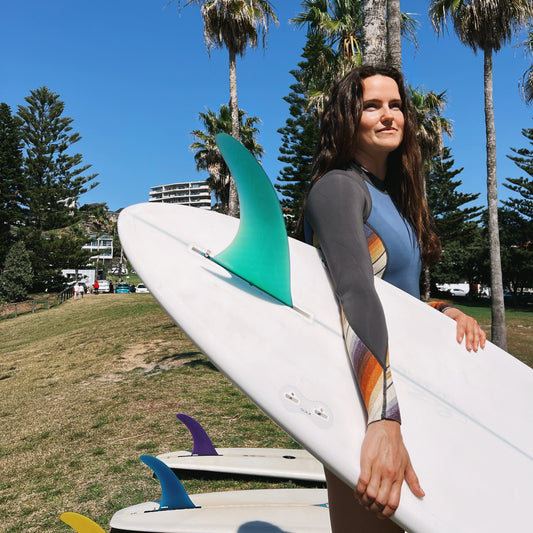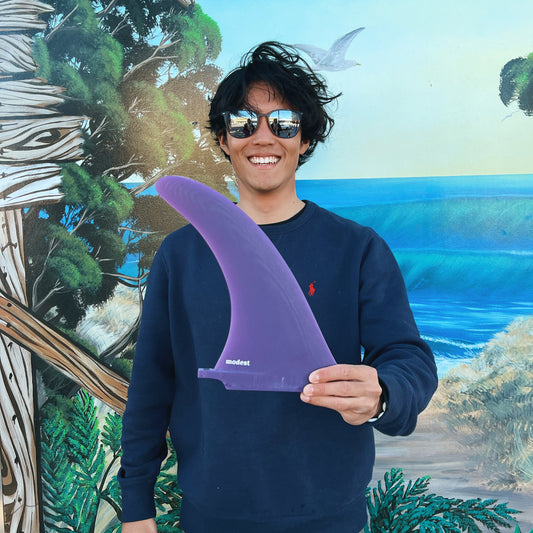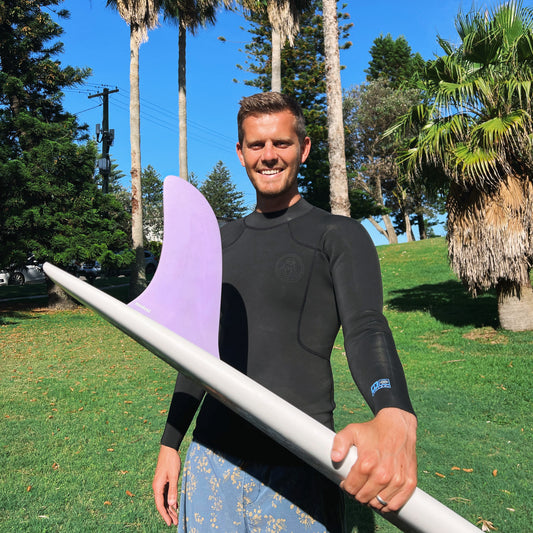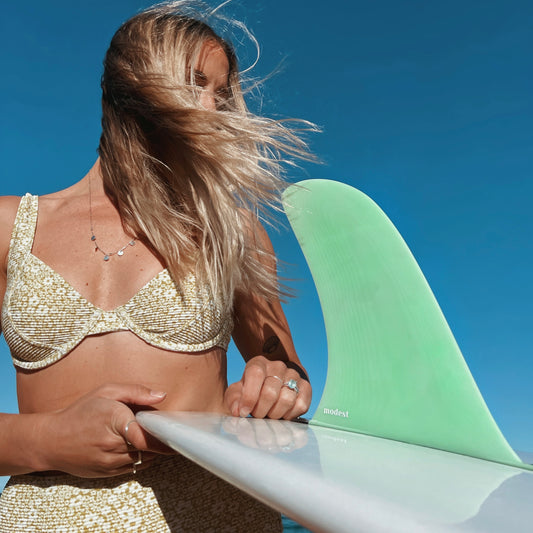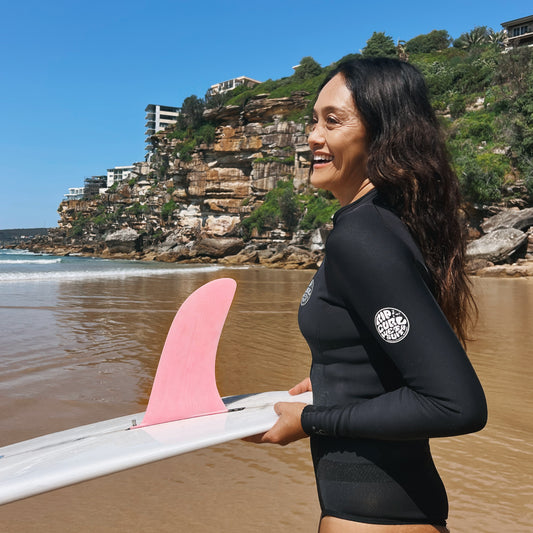Your guide to positioning your longboard fin in your single fin box.
The positioning of your fin on a longboard can significantly influence your performance on the water. Whether you're seeking stability, control, or maneuverability, understanding the differences between having your fin position forward, backward, or centered is essential. In this blog post, we'll explore the pros and cons of each position and discuss how wave conditions impact your decision-making process. By the end, you'll have the knowledge to fine-tune your fin position and optimize your longboarding experience.
Forward fin position: Turns and movement
A forward fin position refers to placing the fin closer to the front of your fin box of your longboard.

Here's what you need to know:
Pros:
- Enhanced maneuverability: With the fin closer to the nose, the board becomes more responsive and agile, allowing for quick direction changes and sharper turns.
- Looser feel: The board feels more playful and free, making it suitable for surfers who prefer a loose and skate-like style.
- Improved speed generation: The forward fin position facilitates the generation of speed and the ability to maintain momentum through turns.
Cons:
- Reduced stability: Placing the fin forward sacrifices some stability, making it challenging to maintain control in more powerful waves or when executing larger turns.
- Limited control: The looser feel of a forward fin position can make it harder to control the board during critical sections or when riding steep faces.
- Potential for spinouts: The increased responsiveness may result in the fin breaking free from the water during aggressive maneuvers, leading to spinouts.
Considerations for Wave Conditions:
- Smaller, mushier waves: A forward fin position excels in smaller, slower waves where quick turns and agility are vital.
- Less powerful waves: When the wave lacks significant power, placing the fin forward can help generate speed and maintain momentum.
Backward fin position: Stability and trim
A backward fin position involves moving the fin closer to the tail of your longboard.

Here's what you need to know:
Pros:
- Increased stability: Shifting the fin backward enhances stability, providing a solid foundation for control during maneuvers and when riding larger or more powerful waves.
- Enhanced control: The fin closer to the tail allows for precise control over the board, especially when executing drawn-out turns or riding critical sections of the wave.
- Improved trim and glide: The backward fin position can optimize the board's trim, allowing for longer glides across the face of the wave.
Cons:
- Reduced maneuverability: Placing the fin further back limits the board's maneuverability, making tight turns and quick direction changes more challenging.
- Slower speed generation: The increased stability and control come at the expense of speed, as the backward fin position may impede the board's ability to generate acceleration.
Considerations for Wave Conditions:
- Larger, more powerful waves: A backward fin position shines in larger waves, providing the stability needed to handle increased speed and force.
- Steeper faces or critical sections: The added control and stability offered by a backward fin position allow surfers to confidently navigate steep sections of the wave.
Neutral fin position: The balanced approach
A centred fin position involves placing the fin in the middle of the longboard fin box.

Pros:
- Balanced performance: The centred fin position offers a well-rounded performance, combining elements of manoeuvrability, stability, and control.
- Versatility: This position caters to a wide range of surfing styles and wave conditions, making it a popular choice for all-around longboarding.
- Adaptability: A centred fin position allows for easy adjustments, enabling surfers to fine-tune their performance based on personal preferences and wave conditions.
Cons:
- Less specialisation: While a centred fin position provides balance, it may not excel in specific aspects like extreme manoeuvrability or maximum stability compared to more extreme positions.
Considerations for Wave Conditions:
- Variable or unpredictable wave conditions: A centred fin position provides versatility, adapting to changing conditions and allowing surfers to adjust their approach accordingly.
Conclusion:
Choosing the ideal fin position for your longboard is really about experimentation and adapting to the specific wave conditions will ultimately guide you towards finding the perfect fin position for your longboarding style.
So, grab your board and try changing up the fin position in between waves in your next session. You will quickly learn the differences and how best to setup your board for the waves you're surfing.
If you're riding a modest fin you will be able to move your fin back and forward with our hand-tightening bolt mid-session.
Enjoy!



